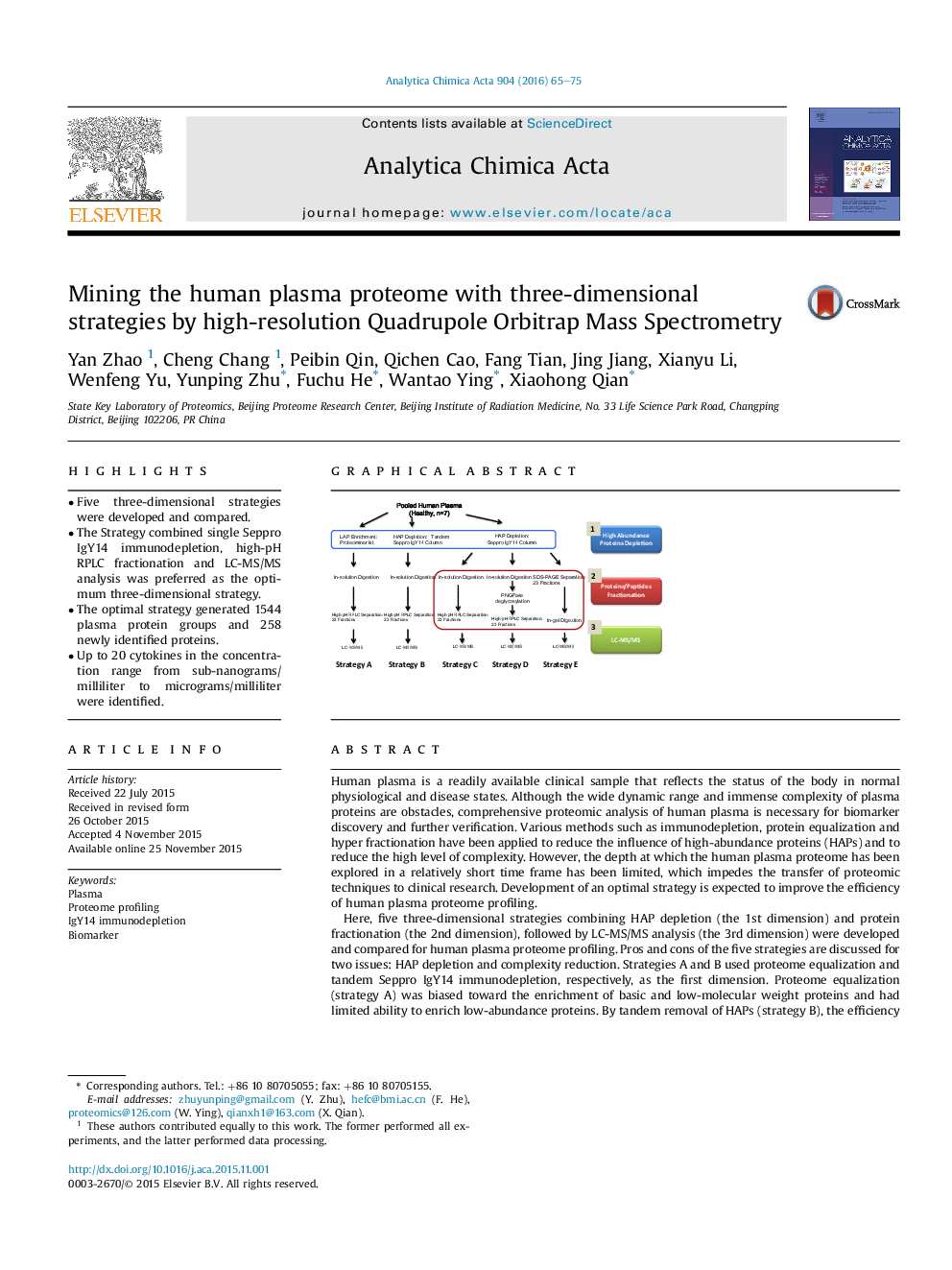| کد مقاله | کد نشریه | سال انتشار | مقاله انگلیسی | نسخه تمام متن |
|---|---|---|---|---|
| 1163215 | 1490928 | 2016 | 11 صفحه PDF | دانلود رایگان |
• Five three-dimensional strategies were developed and compared.
• The Strategy combined single Seppro IgY14 immunodepletion, high-pH RPLC fractionation and LC-MS/MS analysis was preferred as the optimum three-dimensional strategy.
• The optimal strategy generated 1544 plasma protein groups and 258 newly identified proteins.
• Up to 20 cytokines in the concentration range from sub-nanograms/milliliter to micrograms/milliliter were identified.
Human plasma is a readily available clinical sample that reflects the status of the body in normal physiological and disease states. Although the wide dynamic range and immense complexity of plasma proteins are obstacles, comprehensive proteomic analysis of human plasma is necessary for biomarker discovery and further verification. Various methods such as immunodepletion, protein equalization and hyper fractionation have been applied to reduce the influence of high-abundance proteins (HAPs) and to reduce the high level of complexity. However, the depth at which the human plasma proteome has been explored in a relatively short time frame has been limited, which impedes the transfer of proteomic techniques to clinical research. Development of an optimal strategy is expected to improve the efficiency of human plasma proteome profiling.Here, five three-dimensional strategies combining HAP depletion (the 1st dimension) and protein fractionation (the 2nd dimension), followed by LC-MS/MS analysis (the 3rd dimension) were developed and compared for human plasma proteome profiling. Pros and cons of the five strategies are discussed for two issues: HAP depletion and complexity reduction. Strategies A and B used proteome equalization and tandem Seppro IgY14 immunodepletion, respectively, as the first dimension. Proteome equalization (strategy A) was biased toward the enrichment of basic and low-molecular weight proteins and had limited ability to enrich low-abundance proteins. By tandem removal of HAPs (strategy B), the efficiency of HAP depletion was significantly increased, whereas more off-target proteins were subtracted simultaneously. In the comparison of complexity reduction, strategy D involved a deglycosylation step before high-pH RPLC separation. However, the increase in sequence coverage did not increase the protein number as expected. Strategy E introduced SDS-PAGE separation of proteins, and the results showed oversampling of HAPs and identification of fewer proteins. Strategy C combined single Seppro IgY14 immunodepletion, high-pH RPLC fractionation and LC-MS/MS analysis. It generated the largest dataset, containing 1544 plasma protein groups and 258 newly identified proteins in a 30-h-machine-time analysis, making it the optimum three-dimensional strategy in our study. Further analysis of the integrated data from the five strategies showed identical distribution patterns in terms of sequence features and GO functional analysis with the 1929-plasma-protein dataset, further supporting the reliability of our plasma protein identifications. The characterization of 20 cytokines in the concentration range from sub-nanograms/milliliter to micrograms/milliliter demonstrated the sensitivity of the current strategies.
Figure optionsDownload as PowerPoint slide
Journal: Analytica Chimica Acta - Volume 904, 21 January 2016, Pages 65–75
